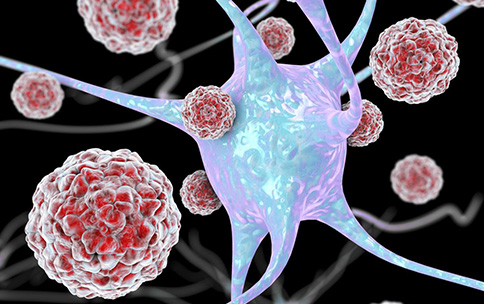
One method of treating genetic diseases is to transfer new genes to cells affected by the disease. One tool scientists use to transfer genes is viruses, which interact with cells through an external covering, and then inject their DNA into the cells. Scientists take advantage of this ability by replacing virus DNA with DNA that encodes the genes they wish to deliver. In addition to treating diseases, this technique can be used to label cells with fluorescent colors in order to visualize them and identify their connections in the body. Using viruses to transfer genes to cells of the nervous system is difficult because neurons (nerve cells) are widely spread throughout the body, and reaching some neurons requires passage of the virus through the blood brain barrier, a selective layer that blocks the passage of many substances from reaching the brain and spinal cord tissue.
In a study led by NIH Common Fund SPARC program-funded investigator Viviana Gradinaru, a research team engineered viruses to efficiently deliver genes to neurons throughout the body of a mouse after injection into the bloodstream. They modified the external covering of existing viruses for more efficient gene delivery to neurons. They engineered one virus to pass the blood brain barrier and transfer genes to neurons in the brain and spinal cord (the central nervous system), and another virus to reach and transfer genes to neurons spread throughout the body (in the peripheral nervous system), including the heart. The engineered viruses are highly efficient at gene delivery at low doses, can be designed for their delivered genes to be turned on only in certain cell types, and are able to precisely label cells with fluorescent colors for visualization. The viruses can be further customized and potentially used for future non-invasive treatments of neurological disorders, as well as for multi-color labeling of neurons for generation of neuron circuit maps. Neuron maps showing connections between neurons and organs could aid in development of treatments for a variety of human diseases by altering the activity of specific neurons through a process called neuromodulation.
Reference:
Engineered AAVs for efficient noninvasive gene delivery to the central and peripheral nervous systems. Chan, KY, Jang, MJ, Yoo, BB, Greenbaum, A, Ravi, N, Wu, WL, Sanchez-Guardado, L, Lois, C, Manmanian, SK, Deverman, BE, and Gradinaru, V. June 2017. Nat Neurosci. 20(8): 1172-1179.
In the News:
Novel viral vectors deliver useful cargo to neurons throughout the brain and body, ScienceDaily
Gene Therapy Vectors Come to Grips with Nervous System, Root and Branch, Genetic Engineering and Biotechnology News


